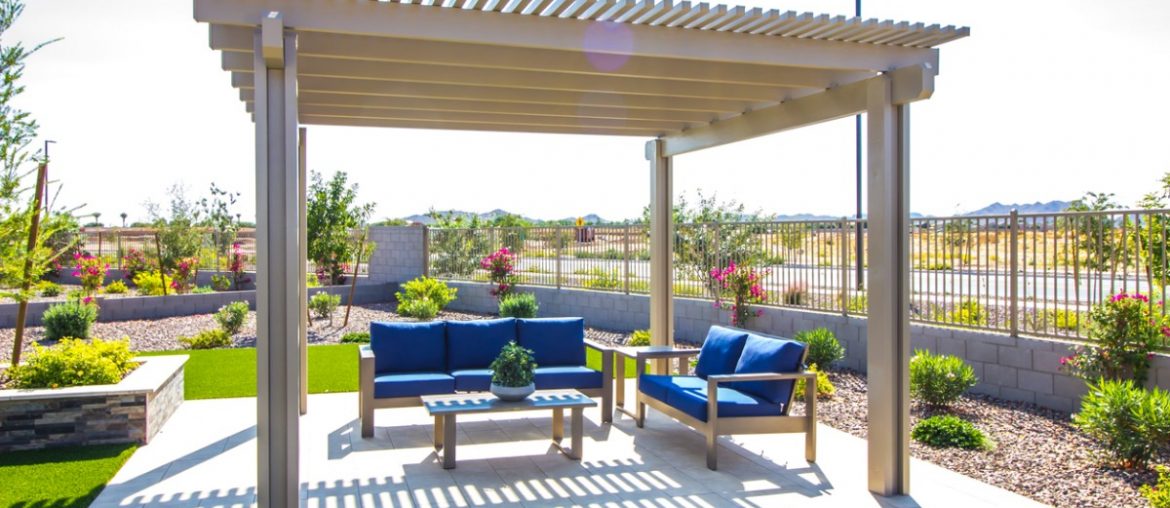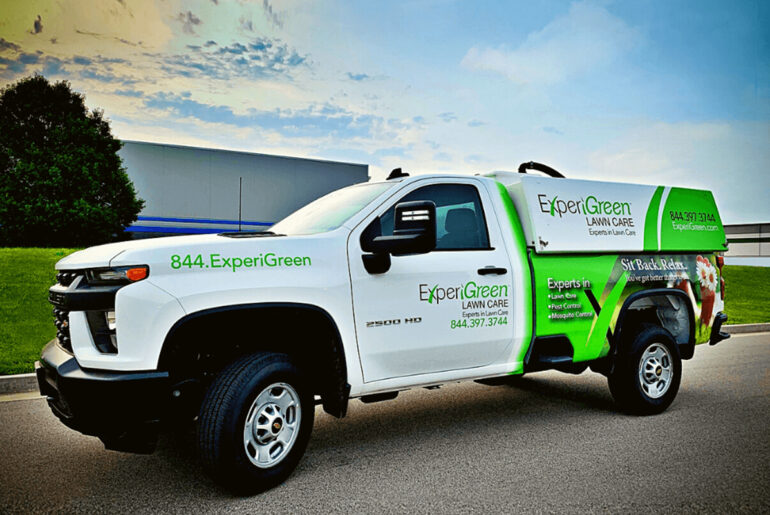Decorating a yard, garden, or patio can be challenging. Not only do you have to find the perfect materials, but you will also decide on colors. Additionally, before you can find the right pergola for you, you must consider the weather in your area.
Fortunately, there are many styles, uses and pergola types. Browsing through the several kinds of pergolas and their uses can help decide which pergola would be the best for each home and decorative needs.
Pergolas add flair, personality, and style to homes. They can also add shade, utility, and tranquility. Some pergolas are a display for plants and vines, whereas others remain clean and clear of all foliage.
With a mixture of elegance and utility, pergolas are a perfect addition to any home. Pergolas can elevate a beautiful home and meld minimalism with Earthy tones to create a surreal and heavenly feel to a location.
What Is a Pergola?
Pergolas are outdoor structures that use overhead cross beams and vertical height to create a canopy. Some outdoor pergolas have a cloth covering netting. Others remain uncovered to form a minimal and clean style.
Some pergolas only have cross beams overhead and offer only partial shade. These traditional pergolas give an air of elegance and can be used to grow beautiful flowers woven in between the beams.
Pergolas are incredibly popular in warm, tropical climates and are dated as far back as the 1600s in Rome. Initially, pergolas began as a way to use vertical landscaping for vining plants to climb upward. However, pergolas have been instead used in modern landscapes to provide shade in garden designs.
Some pergolas work well with a string of lights instead of plants to give a garden an enhanced sense of atmosphere. However, pergolas can be paired with many different components to achieve the desired look.
Some of the most common things to pair with pergolas include the following:
- A string of lights.
- Vining plants.
- Real or fake flowers.
- A mosquito net.
- Chairs or lounges.
- Cloth or wood shading.
Some pergolas come with shading, but others can have shading installed. Additionally, many pergolas can be of varying sizes, have stone pillars, or have modern designs. Pergolas for patios can often be large enough to house a full set of outdoor living space furniture, complete with a table and several chairs and event an outdoor kitchen.
Large pergolas may even be large enough to house horse grills, large potted plants, and a variety of furniture. Pergolas can be as large as you want if you are willing to build or buy them. Building your pergola can be challenging but entirely possible, as well. You can create a pergola for a lesser cost if you have the right tools and equipment.
Uses of Pergolas
Aside from complimenting any outdoor space with its beauty and elegance, pergolas can offer shade, comfort, and an ideal place for gatherings. Many people place outdoor furniture under their pergolas, enabling them to entertain guests in cozy outdoor weather.
A pergola can offer a comfortable seating area while watching children play in a pool or yard. It can also be a quaint location to read a book in peace. Other residents who install pergolas may wish to use them as displays for beautiful vining plants or flowers.
Some pergolas may include a hook for hanging pots or are used to weaving a string of lights for accenting late-night get-togethers. More expensive pergolas can be large enough to house a grill or other cooking equipment and make for a perfect outdoor meal preparation area.
Plants like Trumpet Vines, Dutchman’s Pipe, and purple Clematis are vining plants that can attract hummingbirds and beneficial insects. These plants can also promote a healthy environment by attracting honeybees.
Different Types of Pergolas
There are many types and styles of pergolas. Some can even be modular with moveable rafters to block sunlight and rain. Other pergolas are freestanding, floating, or attached to outdoor patio walls.
The many varieties of pergolas can make choosing one difficult. However, most homes and residential properties will likely only use shaded, freestanding, or floating pergolas, as they are the most consumer-friendly.
Other types of pergolas may be often located at an outdoor eatery or diner, outside a business door, or at a nature preserve location to show off beautiful flowers and other foliage.
Freestanding
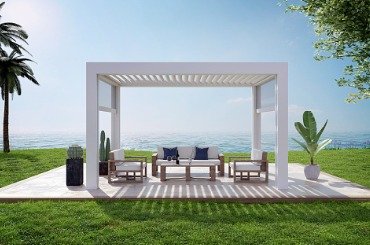
Of the types of pergolas, freestanding pergolas are the most common. These pergolas are often in backyards, on patios, and in yards of residential properties. Freestanding pergolas are dynamic and can be dressed up with potted plants, hanging foliage from the cross beams, or be a home to vining plants.
Some consumers often enjoy planting vining plants at the base of freestanding pergolas and letting those vines circle each pillar and weave between the rafters above. However, there are more options than just plants and foliage. Freestanding pergolas are also dynamic for shading and insect netting, making them ideal places for nighttime meals or gatherings.
Placing furniture below the overhead beams can create a sanctuary for your property. These freestanding pergolas can have varying designs.
Some basic pergolas may have simple wooden or steel pillars. Others may utilize slats, stones, or bricks, but these are less common. Some freestanding pergolas may be grounded using cement and stakes. Anchoring a pergola can be ideal for those who live in an area with volatile weather conditions.
Shaded
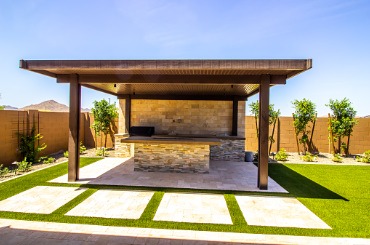
Shaded pergolas are also incredibly common on residential properties and an excellent alternative to open roof designs. Many homeowners purchase pergolas with an enclosed roof to provide more shade and comfort for their backyard, patio, or garden. Shaded pergolas can provide the ideal environment for gatherings, meals, and other get-togethers.
Shaded pergolas offer only shade and let no sun or rain inside, making pergolas with shade a great choice for warm, tropical areas or areas that rain a lot.
Shaded pergolas can have either cloth or hard-topped roofs, making them dynamic. Residents in rainy locations will likely benefit more from hard-roofed pergolas, whereas those in sunny areas will enjoy coverage while maintaining a breeze from cloth coverings.
You may purchase a cloth shade for a freestanding pergola, but some shaded pergolas come with a cloth shade attached that cannot get removed.
Attached

Some residential properties may have an attached pergola over a patio, but attached pergolas are frequently in commercial or dining areas. Food joints may often have outdoor dining areas with pergola ceilings alongside overhead beams and rafters.
An attached pergola has a rooftop similar to a freestanding pergola but will run from one wall of an area to another. It will likely take up the entire space and offer coverage from the sun while maintaining an outdoorsy feel.
Attached pergolas on a residential property may be attached to the home but remain supported by two pillars that match the pergola and home design on the other end of the patio and pergola. These pergolas may have more than two pillars if the pergola is long and covers a larger-than-typical patio.
Arched
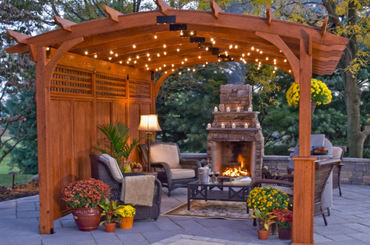
Arched pergolas are often in commercial areas, nature-related properties, and neighborhoods. While this type of pergola is less common for homes, a residential property can use arched pergolas to display flowers, vines, and other beautiful foliage. Commercial areas and nature preservations often use arched pergolas to dress up a space and make a vertical showcase of beauty.
Arched pergolas can span the entirety of a sidewalk, bridge, or pathway and may not need much support in the form of pillars. Unlike other pergolas, arched types may not have four pillars. Sometimes, these pergolas only have two feet, or instead, have walls on either side.
The walls typically have dozens of holes for flowers and other plants to weave in and decorate the pergola. They can have walls of wood, aluminum, or steel.
Some arched pergolas have one solid side with spaces for plants and two pillars on the other side. With standard slats and cross beams atop the pergola, arched pergolas are ideal for strings of lights and hanging plants.
Modular

Also called louvered pergolas, this type of pergola has moveable rafters that are adjustable to avoid sunlight, let in air, and keep you comfortable in all kinds of weather. Some modular pergolas have automatic systems in which electrical components can enable you to change the direction of the rafters with a remote or button.
Some modular pergolas can also have manual rafters that you can move. These may be more tedious, but they can enable you to get just the right amount of sun.
For example, book lovers may want to get the sun out of their eyes or off the page of their book while enjoying warm rays on their legs or other body parts. Modular manual rafters can make this pergola more compelling.
Start Using Lawn Care Software!
Floating or Awning
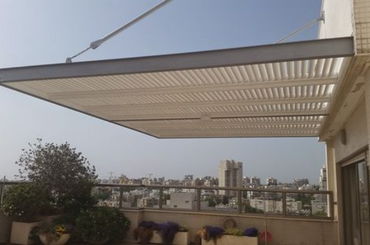
Most commonly located outside of businesses or commercial entrances, floating, or awning, pergolas can make a compelling addition to your property. Floating or awning pergolas provide shade and leave the space underneath ideal for gatherings and outdoor area furniture, which benefits residential properties.
Some residential properties use floating or awning pergolas over a patio or swimming pool to create a more appealing area. These pergolas use poles or wires to anchor into a place higher on the building and thus have no pillars. You may benefit from a more sweeping line of sight by going with a floating pergola as the pillars will not obstruct a beautiful environment.
As with other pergolas, floating pergolas can use hanging plants, strings of lights, or cloth shading. This type of pergola can have modular rafters that adjust through electrical components or manually with a ladder.
Pergola Materials
Many different kinds of materials can create visually appealing pergolas. The most common material for a pergola is wood, but aluminum, steel, and fiberglass can also make pergolas. In some commercial locations, pergolas can have concrete pillars.
If you are building your pergola with wood, the best kind to use is pressure-treated wood as it gives the wood a longer life-span and can prevent rotting and exposure to weather conditions.
Ground contact wood is ideal for the pillars of a pergola as the feet of your structure will be hard to clean and maintain while underground. The overhead beams of your pergola can use above-ground pressure-treated wood.
Pre-made pergola kits will likely use these types of wood. Kits using other materials will likely use quality content.
Pergola Costs
The cost of building a pergola largely depends on the material you are using, if you create your pergola yourself, or any special weather accommodations you may require. Regardless of the pergola installation method, you will likely spend several thousand dollars on your quality pergola.
Pre-Made Kits
A quality pre-made pergola can be as little as $1,200. However, more detailed or massive varieties may cost up to $5,000. These kits still require you to put the pergola together yourself, so you may wish to compare pricing with a local landscaping company to discover if you can get your pergola built with better quality for the same price.
Building Your Pergola
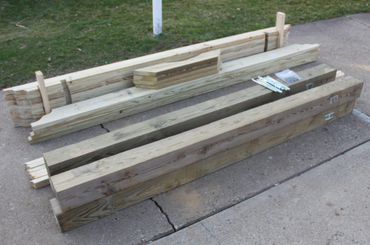
Building your pergola can save you several thousand dollars, depending on the size of the pergola you wish to make and how stylish or detailed the design you are attempting to build is.
Building your pergola can cost anywhere from $1,300 to $10,000. The average cost is about $4,000. When you have decided on your installation method, you can move forward with the process. This process can be as simple as consulting with a professional or as challenging as managing the transportation of lumber and acquiring other tools.
Choosing The Right Installation Method
If you use contractors or laborers to put together your pergola for you, then installation will be a matter of making an appointment with a team of qualified professionals. However, embarking on a mission to build your pergola can be simple. There are several options from which you can choose.
You may want to purchase all the materials and cut each piece yourself. Additionally, pergola kits are available with all necessary components inside a box and require you to put them together.
However, there is the risk that you may not put it together correctly. Getting a professional to put together your pergola can save a lot of headaches if you are willing to spend the money on professional work.
Getting the materials and cutting everything yourself will require more work, but save much more money. This option will also allow you to design your pergola just the way you want it. However, the result may not turn out looking the way you wish.
A pre-made pergola kit can be pricey, but it can save a lot of time building and come with everything you need to get the job done. While this option is more expensive, it can provide you with a quality product that meets expectations.
Getting a professional will cost the most money but guarantees a satisfying product of the highest quality. Getting a professional is the easiest option, as you will have little work to do aside from general consultation with the landscaper.
Each option will have a high cost but can leave you with a quality product. No matter which installation method you choose, the first few steps are the same:
- Measure and map out the area you wish to place your pergola. Remember to account for height.
- Decide on the type of material: wood, aluminum, steel, fiberglass, or concrete.
- Account for plants in your yard or area.
- Weigh plants you wish to hang on your pergola. You will want to ensure that the material you purchase can sustain the weight of hefty plants.
Consider weather conditions and patterns in your area. You may wish to anchor a pergola into the ground if you live in an area prone to tornadoes or hurricanes.
Pergolas Are A Beautiful Touch To Any Yard Or Garden
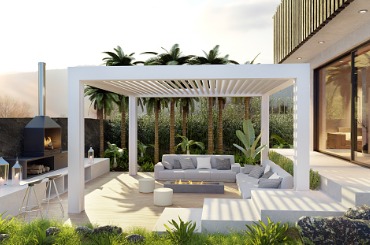
There are many different styles and types of pergolas, but they all can add utility and elegance to your yard, patio, or garden. Whether you are looking for a shady, outdoor play area for your children or a chic location to relax with a good book, pergolas can address many of your decorative needs.
Shaded, freestanding, or arched pergolas can offer you shade from the sun and a place for nearby plants to vine upward. While a pergola is different from gazebos, trellises, and pavilions, it can have similar functions in providing beauty and a place to relax on your property.
Many unique components to pergolas make them clear choices for your next furnishing option. Alongside shade and comfort, a pergola can transform your yard or patio from a dull landscape to a thriving and environmentally healthy paradise.
Stylish and cozy areas to relax, read, or watch the weather are ideal components to your home, and choosing one of the many materials pergolas need can help boost your home’s potential. Whether your pergola is wood, aluminum, or steel pergola , you can rest assured that your pergola will deliver elegance, tranquility, and environmental joy.

